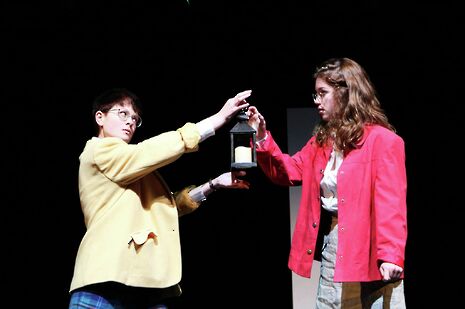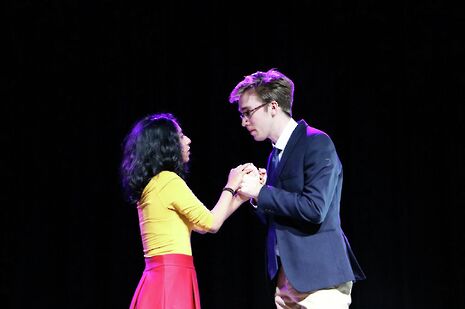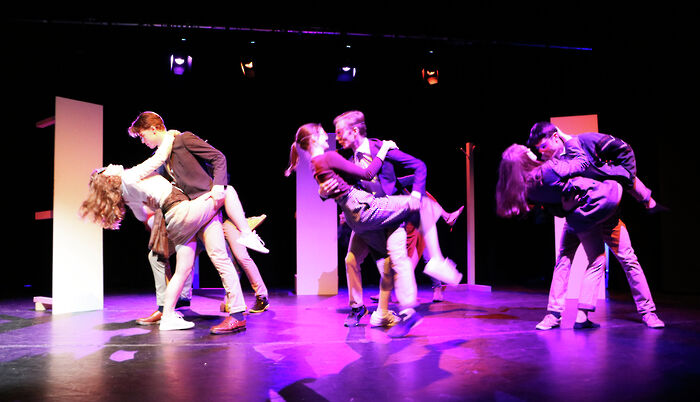Much Ado About Nothing review: ‘both sophisticated and fun’
This year’s ETG shines with a playful production of one of Shakespeare’s most popular comedies

The stage is bare, apart from a white box illuminated by a single spotlight. When the cast comes on stage, they are tense and constrained. Their identical beige and white costumes, the bleak stage and the ominous sounds blaring from the speakers make this seem more like the opening of a dystopian thriller rather than one of Shakespeare’s most popular comedies.
But this effect does not last long. The rest of the first half is light-hearted and cheerful. Set, lighting and costumes are expertly combined into a unified aesthetic that consists of bold colours and shapes. The design of the set is especially ingenious: the white box from the beginning is taken apart, revealing colourful set-pieces, props, and costumes that are imaginatively repurposed throughout the show. Designer Jack Parham’s work is a great example of consistent design across the different production elements which harmonise well with the tone of the show. Scene transitions and choreography are often accompanied by music, which sometimes works and sometimes doesn’t. Cello covers of recent pop songs do contribute to the fun, upbeat atmosphere, but the music is not integrated seamlessly into the otherwise great pacing of the show. Songs either play for only a few seconds before stopping abruptly or continue on throughout the dialogue, distracting from what is being said in the scene.

The crucial dynamic in this play is the relationship between Benedick and Beatrice. A lot of the humour hinges on how these two interact with each other, and Stanley Thomas and Shimali De Silva are clearly up to the job. Stanley’s comic reactions especially produced an impressive amount of laughter from the audience, and Shimali shone in her portrayal of Beatrice’s anger at her cousin’s slander. The timeless love-hate relationship between these two characters is one of the things that make this play so enjoyable for any audience, and the comic timing between the two actors makes the gradual shift in their interactions very entertaining to watch. A special shout-out goes to Kate Collins and Georgina Taylor as Dogberry and Verges, the guards in charge of the night watch; the comic ineptness of these characters is difficult to pull off in front of a modern audience, but Kate and Georgina rise to the challenge.
There are no weak links in this cast; they are well attuned to each other after touring through Europe over the Christmas vacation, and yet their performance does not feel over-rehearsed. They are kept on their toes by the hefty and extensive dialogue in this play but always remain in control of the lines. Beyond delivering the Shakespearean dialogue in a way that sounds natural to us, they introduce additional levels of humour to the pre-existing script through physical gestures.
The second half of this comedy is much less light-hearted than the first, and the shift in tone is definitely noticeable, but the actors still manage to break up the drama once in a while with well-timed, comic reactions and interactions. The more serious moments are expertly acted and sometimes even sung. The set and costumes, which are still held in bright colours, don’t take away from the tragedy of the second half; the naïve, childlike visual elements actually strengthen its impact.
Much Ado About Nothing is a script that lends itself well to a playful production that everyone, not just Shakespeare fans, can enjoy. Director Geraint Owen and his team have succeeded in delivering a show that kept the audience engaged for over two hours, both through laughter and emotionally moving moments. This is professional-looking Shakespeare that manages to be both sophisticated and fun; it is skilful without taking itself too seriously.
Much Ado About Nothing is on at the ADC Theatre at 7.45pm, 16-20th January
 News / Eight Cambridge researchers awarded €17m in ERC research grants27 December 2025
News / Eight Cambridge researchers awarded €17m in ERC research grants27 December 2025 News / Downing investigates ‘mysterious’ underground burial vault 29 December 2025
News / Downing investigates ‘mysterious’ underground burial vault 29 December 2025 Lifestyle / Ask Auntie Alice29 December 2025
Lifestyle / Ask Auntie Alice29 December 2025 Sport / Hard work, heartbreak and hope: international gymnast Maddie Marshall’s journey 29 December 2025
Sport / Hard work, heartbreak and hope: international gymnast Maddie Marshall’s journey 29 December 2025 Interviews / Meet Juan Michel, Cambridge’s multilingual musician29 December 2025
Interviews / Meet Juan Michel, Cambridge’s multilingual musician29 December 2025









